RAFAEL Augusto Bordalo Pinheiro was born on the 21st of March 1846 in Lisbon, at 47 (currently 33) Rua da Fé. He was the third son of Manuel Maria Bordalo Pinheiro, a public officer, encyclopaedic artist, painter, sculptor, engraver, and Maria Augusta Prostes. Rafeal grew up in an artistically oriented environment. Due to their age, he developed a close relationship with his elder brothers, Manuel, a naval officer and Feliciano, the manager-to-be of the Caldas de Rainha Faience Factory. However, due to their artistic tendencies, he also spent much time with his sister Maria Augusta, the fine creator of wonderful laces, and his brother, the great Columbano. He spent his youth at the house of his parents at the 'Praça de Alegria', where together with his elder brothers, he held meetings with friends such as Gomes de Brito, who wrote his biography. He also spent some time at the house in 'Rua da Correnteza', in Alcolena, where some of the most important contemporary artists and writers used to go. Columbano painted some of the meetings held there.
Rafael was quite restless and whimsical, preferring not to follow any rules. This caused him not to finish his studies, to the great displeasure of his kind father. He even enrolled at the Academy of Fine Arts, the Arts Faculty of the University and the Academy for Performing Arts, but he neither finished anything nor attended any classes. He was very creative and spontaneous and depended on his ability to teach himself. In reply to someone who asked him about his qualifications in Brazil, he replied that he graduated from the 'Rua do Ouvidor', a five-year singing course!
He tried the Performing Arts as a very young actor at the Teatro Garret' in the Travessa do Forno', Anjos. Being a very demanding reviewer, he considerd himself a failed comedian and this made him give up this career. However, he was still fond of the theatre and was involved in staging, helping some actors to become famous.
He married Elvira Ferreira de Almeida in 1866, against the will of her parents, after having abducted her from her parents' home. As this marriage was based purely on love, they had a peaceful relationship, despite the love Rafael had for the lovely Maria Visconti, which only remained hidden due to Rafael's discretion. He had three children, Manuel Gustavo (in 1877), followed by Helena Bordalo Pinheiro and another daughter who died in childhood. He was not only dedicated to his wife and children but also to his parents and brothers. A family portrait designed in Brazil, when his mother passsed away, shows how much he loved his parents. This portrait is called 'Looking Back to the Past' and he manages to express quite well how much he missed his country and relatives. Again, when his father passed away in 1881, Rafael and his brother Columbano dedicated to their father some tender pages entitled 'António Maria'.
Very much influenced by his family, he originally wanted to be a professional artist. Between 1867 and 1874 he often entered competitions organized by the" 'Sociedade Promotora de Belas Artes' (Fine Art Promotion Society). Most of the time his works focused on popular themes. Landscapes did not interest this very sociable person. It was man as a social being that interested him and it was to become the inspiration for all kinds of artistic productions.
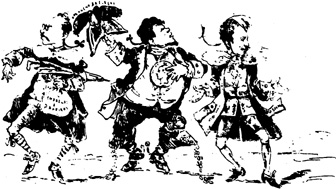
He participated in Promotora's exhibitions, winning a few prizes, but because he needed to earn money, he tried his hand as a caricaturist. At the same time, he worked as an illustrator and decorator, preparing magazine covers, making drawings for novels, helping with almanacs, making lithographics and advertisements. He also worked on foreign magazines such as "El Mundo Cómico" (1873-1874), "Illustrated London News" (1873) and "El Bazar". Ingram, one of the owners of the "Illustrated London News", needed someone to illustrate the row between the Carlists and the Liberals in Spain. Rafael Bordalo Pinheiro, who had been introduced to Ingram by Tomás de Anunciação, left for Spain in March 1873. The drawings that he sent them were so good that he was invited to move to London. However, he was very much attached to his country and family, so he turned down this and other invitations.
He was also attracted to the theatre. He participated in "Os Teatros de Lisbon," by his friend Júlio César Machado, For that play he made around two hundred delicate drawings. In 1873 he made lithographs of actors and actresses to be included in an album, but he never really finished it.
It was, however, in the field of caricature that Rafael reached his peak. He became the first and most important Portuguese caricaturist. He started drawing caricatures for fun in the old corridors of the Convent of Jesus to amuse his friends. But caricature became his major choice in 1870 following the success of "O Dente da Baroneza". Another success was 'O Calcanhar de Aquiles' (1870), an album which featured some of the most important people in Lisbon's literary circles. Still in 1870 he published the first satirical caricature newspaper "A Berlinda", a lithograph paper of which seven issues were published. However, he suspended its publication on the third issue and came up with 'O Binóculo', a weekly magazine of caricatures which was on sale at theatres. In December 1870 'O Binóculo' was suspended and four more issues of 'Berlinda' were issued.
Guilherme de Azevedo and Guerra Junqueiro who worked under the pseudonym of Gil Vaz, which they had used before as the authors of 'A Lanterna Mágica', a satirical newspaper was launched on the 15th of May. With his newspaper, Rafael began a systematic criticism of institutions, the Government and politicians. The symbol Zé Povinho' representing the Portuguese people was first displayed in this newspaper.
The success of these caricature newspapers made him aware of his own identity as an artist, intellectual and citizen, At the same time, he realized that he now had a powerful weapon with an educational influence over society. In 1847 he decided to break the routine and dedicated himself exclusively to caricature work, since his first attempts in this field had been successful.
In fact, Rafael Bordalo Pinheiro possessed a variety of features which any caricaturist needs, for example, a critical spirit, the abitity to reduce situations and people to their basic elements, psycological perception, sensitivity to others, incisive and fast drawing skills, intuition and the ability to perceive only the important outlines. With all these features he was destined for a great career.
He was the idol of Lisbon's intellectual and Bohemian youth and got along with writers, artists and actors who gave him a good opportunity for observing human nature. His criticism was aimed at the core of society and his drawings represented it admirably.
Despite this initial success and as he could not devise a way to release himself from his day-to-day obligations, he accepted a proposal made by Manuel Carneiro, editor of 'O Mosquito', a humorous newspaper from Rio de Janeiro. He suspended the publication of 'A Lanterna Mágica' on the 31st of July 1875 and to the surprise of his friends he left for Brazil aboard the ill-fated 'Postoi' on the 19th of August 1875,
He stayed five years in Brazil, but was continually homesick for his family and country. In fact, Rafael Bordalo Pinheiro could never get accustomed to other countries. In 1876 he sent for his wife and daughter, who was still a baby. His son, Manuel Gustavo stayed with his grandparents. Nevertheless, he could never forget his country and kept on sending contributions to newspapers and magazines. In 1876, a book entitled Album de Phrases e Anexins da Língua Portuguesa featuring drawings by Rafael and engravings by Severini, Alberto and Pastor, was published in Lisbon.
However, Brazil's hostile environment and Rafael's impulsive behaviour, which was very much against the corruption in Brazilian society, where the Portuguese immigrants were very often humiliated, wounded Rafael's patriotic feelings.
In reply to an attack made by the Baron of Lavradio who accused some Portuguese of going to Brazil to get rich without working, Rafael ordered a blue jacket with three rows of ten mother-of-pearl buttons. Wearing this jacket and white trousers, the colours of the Portuguese flag, he paraded in the main city streets.
After a short collaboration with 'O Mosquito', of which he was to become editor, due to a quarrel with Manuel Carneiro, Rafael founded the 'Psitt!...' in 1877, of which only nine issues were published. Rafael created new symbols like 'Psitt!, an elegant humourist, 'Botafogo', 'Arola' and 'Canal de Mangue'.
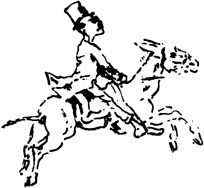
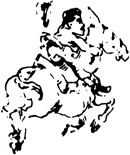
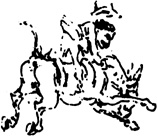
He launched a new magazine 'Besouro,' which lasted for just one year (1878-1879). This magazine introduced a new symbol, 'Fagundes', a kind of councillor.
While in Rio de Janeiro, Rafael made friends and enemies, Some of the latter even tried to kill him. Following the second attempt to kill him and in view of his wife's demands to leave Brazil, he decided to return to Portugal. Aboard the steamer Valparaíso, he arrived in August 1879, after which the most brilliant phase of his career as a caricaturist was to begin.
In fact, Rafael Bordalo Pinheiro reached the peak of his political and social career with the publication on the 12th of June 1879 of the first issue of 'O António Maria', a newspaper which was aimed at criticizing the political and artistic life in Portugal. 'O António Maria', together with his 'Album das Glórias' are considered to be masterpieces of personal and political caricature in Portugal.
Although he had never been fully engaged as a politician, Rafael was very much interested in what was going on around him and he worried about his country. Then, on the pages of 'O António Maria' (1879-1885) and (1891-1899) and 'Pontos nos ii' (1885-1891), which was published between the first and second series of 'O António Maria', Rafael revealed himself as a strong critic of the decadent monarchic structures and a supporter of the rising Republican party. In fact, through his caricatures the Republican ideas were quite easily spread among the people. 'O Voto Livre' and 'Amorda Pátria' among other compositions, portrayed a character symbolizing the Republic, which was the manifestation of a high ideal.
In order to learn more about the politician, critic, pamphleteer, and independent man, it is necessary to examine the papers of this period. Some facts related to the existence of these papers and the characters portrayed therein give us important clues about his courageous personality. Let us take, for instance, Rafael's reaction to the journalists' strike in January 1895 which caused the first suspension of 'O António Maria. He supported the strike and some of his colleagues stated that he could affort to support it only because his paper was published weekly and the strike would not affect it. In reply to this accusation, he suspended the publication of the paper and announced that he would become a brickmaker...
In fact, in addition to his other activities, Rafael became a potter in 1884. His first work appeared in April 1884 at the Gomes de Avelar factory, in Caldas da Rainha, which was managed by his brother Feliciano. There, Rafael produced a great number of very original pieces which play a role in the renovation of artistic ceramics in Portugal and strike us with their exuberance and newness.
His ceramic work ranged from simple dishes to artistic vases, palace halls to amusing popular and political caricatures. However, as he did not manage to translate his criticism through these ceramic works, he returned to the newspaper.
On 7th May 1885, the first issue of 'Pontos nos ii' was released. This was not very different from its predecessor in terms of content and shape. However, his patriotism was clearly shown on the works concerning the 'England Affair', 'Tobacco Monopoly', 'Ultimatum' and 'Oporto uprising of 31st of January'.
There he denounced openly the policy of compromises carried out by the late Liberal governments. The violent pages on the Oporto Uprising of the 31st of January and mainly the noxious text by Fialho de Almeida (lrkan) caused the suspension of 'Pontos nos ii', issue 293, of the 5th of February 1891, by order of the Civil Government. On the 5th of March, the 'O António Maria' series 2, was published.
Disillusioned at the public's disinterested attitude and deeply disenchanted with the petty acquiescence after the 'English Ultimatum' of 1890, the fighting pamphleteer developed into a critic and commentator of social events. The pages that he dedicated to Sara Bernhardt and Duse, the 1897 Carnival, Gala Concerts at S. Carlos and many other events occurring in Lisbon towards the end of the 19th Century, are fine examples of his critical and artistic works.
Rafael's last newspaper 'A Paródia' launched in January 1900, in which his son's contribution was more important than his own, shows a less combative phase even though he managed to keep his usual irony. He then started to despise the political games and opportunism and this feeling was expressed in some articles in this weekly publication dedicated to politics: 'The Great Pie,' Finance: The Great Dog and the Economy: The Brooding Hen.
In his last phase he became melancholic and a famous caricature portrayed the two extremes of his life. At one extreme is the thirty year old Rafael, still very strong and at the other, twenty years later, we see Bordalo asking for a light from the younger one.
On his return from a trip to Oporto, where he attended to the carnival decorations, he passed away at his house in Rua de Abegoaria (currently Largo de Rafael Bordalo Pinheiro) on the 23rd of January 1905.
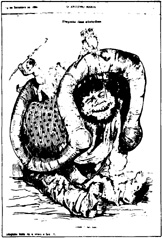
The Character Artist
RAFAEL Bordalo Pinheiro grew in an artistic environment and when still very young he showed his artistic ability. Júlio César Machado, his friend and probably his best biographer, in his preface to Album de Caricaturas (1876), says that Rafael's first drawing, a copy of a lithograph of a peasant family by the sea waiting for an absent child, dated from 1857 when he lived in Cacilhas with his family to avoid the yellow fever. His family was very excited with his drawing because Rafael was hardly ten years old. The only thing worth noting from this drawing is that he already had a tendency towards popular scenes. This was to become the artist's driving force as a caricaturist.
He was attracted to the theatre after 1863, but after getting married in 1886 he chose art. After his marriage he stayed for quite a while at his godfather's in Golegã. There he spent his time doing drawings and water-colours. Dating also from that period are some of his studies and an interesting sketch album. From those sketches one can see that even though he tried landscape themes, he was mostly interested in the human being and the popular types surrounding him. After moving to Lisbon, Rafael finished some of these studies and sent them to be shown at an exhibition organized by 'Sociedade Promotora de Belas Artes'. The works received public acclaim and were awarded an honourable mention in 1867 (the first exhibition) which encouraged him to continue, From 1867 to 1874 Rafael's drawings and water-colours were shown on a regular basis at the Promotora's annual exhibitions.
The economic failure of his first caricature newspaper 'O Binóculo' and 'Berlinda', regardless of the success of his caricatures, made him pay more attention to his drawings and water-colours, which resulted in his best work, It was the charcoal drawing entitled 'Bodas na Aldeia' or 'A Volta da Igreja', which was described by Júlio César Machado as 'an outstanding work of talent, simplicity and composition where truth and grace shine together'. In 1871, it was sent with seven other watercolours and drawings to the Madrid International Festival. There, one of his drawings was awarded an honourable mention. This drawing was once again shown at the 9th exhibition the of 'Sociedade Promotora de Belas Artes' after which it was sold to the Count of Casal Ribeiro for a price not commensurate with the time the artist had spent drawing it. This great charcoal drawing and all preparatory sketches are now on display at the museum dedicated to this caricaturist, Some of his works were displayed at the 10th exhibition of 'Promotora' in 1874, However, as the 'Almanaque de Caricaturas' (1873) and mainly the 'A Lanterna Mágica' (1875) were very successful, which confirmed his ability as caricaturist, he decided to give up his artistic career. In fact, only through the influence of his father was he awarded some modest 'honorable mentions'.
In addition to drawings and watercolours and a few oil paintings, Rafael did some engravings in the early stages, and it seems that his involvement in this field brought something new. According to Júlio César Machado, engraving on wood blocks owes him a lot, as Rafael was the first in Portugal to attempt engraving in lightdark colours, He also tried engraving in zinc and studied how to make etchings with mezotint. The Rafael Bordalo Pinheiro Museum has several etching engravings which show that he was committed to the development of his technique. He used this technique for reproducing prints about nature, like his drawings, watercolours and some of his caricatures, included mainly in 'O Calcanhar de Aquiles' (1870) and 'Album de Caricaturas' (1876).
Rafael was also an illustrator and was Inspired by the same popular groups and scenes that he featured in his drawings and watercolours displayed at the Promotora's exhibitions, In fact, he collaborated in 'El Mundo Cómico' with four engravings, namely 'A Cosquevilheira', 'A Ovarina', 'Os Fadistas' and 'Andador de Almas' which were published consecutively in the 1st, 2nd and 3rd series of that famous Madrid magazine between 1873 and 1874, He sent two illustrations of popular types 'Chicos Jogadores de A Petisca' and 'El Vendedor de Husos e Ruelas' to a Spánish magazine 'El Boasar.' The 'Illustrated London Almanac' in its 1875 volume, also Included a print of a watercolour entitled 'The Portuguese Fisherman'. It is very likely that the very same volume featured other of Rafael's works, but no reference to that effect was made.
In Portugal, in addition to the work that he sent regularly to the publisher Matos Moreira, he also contributed to J. Pedroza's album entitled 'A Gravura de Madeira em Portugal' with the engraving 'Os Fadistas', as well as other periodic publications. Besides the frontispiece and various vignettes, some featuring popular scenes, the magazine 'Artes e Letras,' managed by Rangel de Lima, included in Its first volume (1872) two of his engravings 'Os Dois Pequenos' and 'O Rapaz dos Phósphoros' respectively. He sent 'O Fogo da Petisca' to 'Diário Ilustrado' and it was included in issue no. 469 dated 29th November 1873, besides some small portraits.
Later, during the period of his success he collaborated in David Corazzi's 'Album de Costumes Portugueses', with a watercolour representing one of the popular types that most attracted him, the 'Alfacinha', a person born in Lisbon wearing a cape and kerchief; the Velha Maria', 'Alcoviteira' or 'Mulher de Capote e Lenco'.
Also in the initial phase, he attempted portraiture, a field which he would never leave throughout his life, mainly as a caricaturist. Besides some oil and charcoal portraits of members of his family, the oil painting entitled 'Cabeça de Senhora,' representing his sister Maria Augusta, the charcoal portrait of his brother Columbano with traces of caricature, Rafael also made some portraits of contemporary characters which were published by 'Diário Ilustrado': Manuel Maria da Silva Bruschy, no. 439,1873; Jaime José Ribeiro de Carvalho, no, 439, 1874; Rafael Zacarias da Costa, no. 921, 1875, The portrait of Rebelo da Silva included in 'Contos e Lendas da Nossa Terra' (1874) as well as the portrait of editor João da Silva Matos (1874), were drawn by Rafael. Most of his portraits featured characters related to show business such as actors, actresses, playwrights, managers, etc.
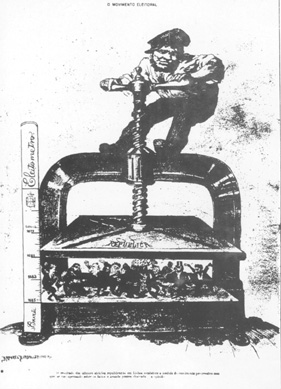
“Macau Contemporary Artists”
One can say that in the initial stage of Rafael's career, there are a series of unfinished works, sometimes just sketches, which were abandoned because they might not have met the artist's expectations. On the other hand, with the exception of some portraits dating from that period, his artistic life covers just a few pencil and charcoal drawings and some watercolours. There are also some oil paintings, but all of these forms of representation are inspired by popular types and customs such as the farmers who attracted him so much during his stay In Golegã after his marriage; villagers that he met in Lisbon everyday; poor children; fishwives; folk bands at fairs and markets; people at work, suffering or humiliated. He was then a social critic, which later he would emphasize so as to become an outstanding caricaturist. Therefore, this initial stage of his career was a trial period which was to develop his artistic ability and critical spirit.
(This article is the transcription of two texts written by Mrs. Irisalva Moita, entitled 'Rafael Bordalo Pinheiro, the Man and the Artist' and Rafael Bordalo Pinheiro, the work', respectively. These two texts were Included In the catalogue Rafael Bordalo Pinheiro and the Portuguese Republic', published by I.C.M., National Library/Publications Department).
Translated by Marie Imelda MacLeod
* Head Curator of Lisbon's Municipal Museums.
start p. 112
end p.